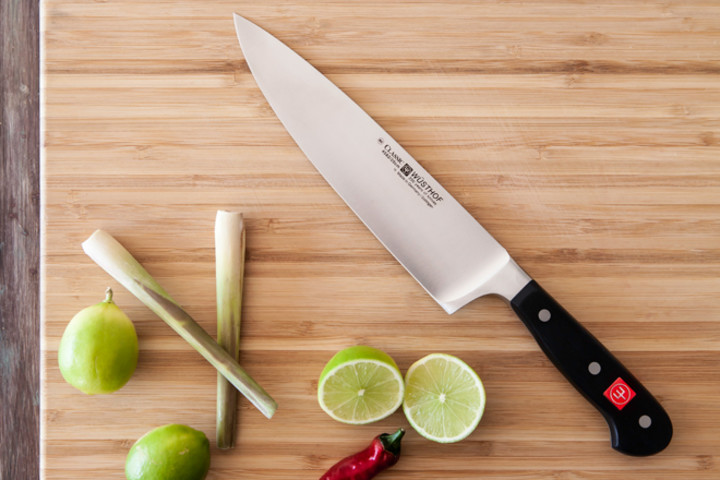Last updated on January 20th, 2024 at 02:04 am
Kitchen knives appear limitless. Each knife has a purpose, from chef’s to utility. Hollow-edge knives are sharp and precise. This article discusses hollow edge knives, their benefits, and how they can improve your cooking. Let’s start exploring hollow edge knives!
What Is a Hollow Edge Knife?
Granton knives, also known as hollow edge knives, have oblong-shaped excavations along the blade’s edge.
Air gaps between the blade and ingredients reduce resistance and make cutting and chopping easier. When cutting fruits, vegetables, and proteins, this hollow edge shape is ideal.
The Science Behind the Hollow Edge Design
Its clever design makes the hollow edge knife function well. Hollowed-out indentations on the blade create air spaces that insulate food from metal.
This revolutionary blade shape reduces surface tension, preventing food from sticking. Thus, slicing becomes smoother and more precise, making thin, uniform slices easy and accurate.
Advantages of Using a Hollow Edge Knife

Hollow-edge knives improve cooking. Let’s examine these benefits:
High-Quality Cutting
These knives’ hollow edges cut well. Indentations produce air pockets that reduce drag, making the knife glide through food. When cutting herbs or thinly sliced fish, this feature is useful.
Low Food Adhesion
Hollow-edge blades reduce food adherence. Air pockets in the indentations prevent ingredients from clinging to the blade, reducing uneven cuts and ripping.
A hollow-edge knife cuts through sticky foods like cheese and moist meats without clinging to the blade.
Less Friction and Fatigue
Hollow edges reduce friction, making cutting easier. The blade glides through food, eliminating hand and wrist fatigue. Chefs and home cooks who spend long hours in the kitchen benefit from this feature.
Kitchen Versatility
Hollow edge knives can cut almost anything. These knives slice, dice, and chop well. Hollow-edge knives are reliable for cutting everything from delicate garnishes to tough meats.
How to Choose the Right Hollow Edge Knife?

Choosing a hollow edge knife involves several criteria. By considering these factors, you may choose the right knife.
Blade Material
Blade material determines knife performance and durability. Due to its corrosion resistance and edge retention, high-quality stainless steel is popular for hollow edge knives. Premium knives will last longer and cut better.
Handle Comfort
A good grip requires a comfortable, ergonomic handle. Find a hollow-edge knife with a comfortable handle that grips well even when wet. Slip-resistant wood or synthetic handles with textured grips are ideal.
Weight and Size
Choose the right knife size and weight. Tasks depend on blade length. For intricate work, a shorter blade is better than a longer one. Balanced knives are easier to handle and prevent fatigue.
Regular Upkeep
Hollow-edge knife upkeep is essential. Choose easy-to-clean knives. Easy-to-clean stainless steel blades resist stains and corrosion. Consider if the knife is dishwasher-safe or needs hand washing to keep its edge and longevity.
Budget
Consider your hollow edge knife budget. High-quality knives may cost more but perform better and last longer. However, cheaper solutions can still cut well. Balance your budget with quality.
Reviews and Advice
Read reviews and get advice before buying. The knife’s effectiveness, durability, and general pleasure can be learned from other users. Online forums, cooking communities, and professional chef endorsements might help you decide.
Questions (FAQs)
Hollow-edge knives for chefs only?
No way! Hollow-edge knives work for chefs and household cooks. Their cutting ability and ease of use make them essential culinary tools.
Can a hollow-edge knife cut bread?
Hollow edge knives can also cut bread. Serrated bread knives cut bread best.
Hollow-edge knives need sharpening?
Hollow edge knives need regular sharpening like any other kitchen knife. To maintain the hollow edge, see the manufacturer’s specifications or hire a professional sharpener.
Hollow-edge knives for bone-in meats?
Hollow-edge knives are unsuitable for bone-in meats. They’re meant for precision cutting and can break if used on bones. Meat cleavers or butcher knives are suitable for bone-in meats.
Hollow-edge knives dishwasher-safe?
It’s knife-specific. To keep hollow edge knives sharp, hand wash them. Check your knife’s manufacturer’s cleaning and maintenance recommendations.
Hollow-edge knives on cutting boards?
Hollow-edge knives work on cutting boards. However, wood or bamboo cutting boards are best for knife edges. Cutting glass or stone can quickly dull the blade.
Conclusion
Finally, a hollow edge knife is a useful culinary tool. Its innovative shape improves cutting effectiveness, lowers food adhesion, friction, and fatigue, and allows for many cutting jobs.
Consider blade material, grip comfort, size, weight, and upkeep when purchasing a hollow edge knife. A high-quality hollow edge knife can improve your cooking skills and give you precision.
